University Spaces as Agents of National Belonging: Analysing the Visual Culture of Public Universities’ Campuses in India and Pakistan
Abstract
:1. Introduction
2. Educational Spaces and Visual Culture
‘the ready-made standardised visual scheme handed down by previous generations of teachers and authorities as an unquestioned and unquestionable guide to all observable events, rituals, situations, objects, materials, spaces and behaviours which normally occur within everyday schooling.’
3. Methodology
4. Key Findings
4.1. Symbolic Artefacts at the University Premises
4.2. Furthering Nationalism and Patriotism through Walls of Heroes
4.3. Political Graffiti and Art on the Walls of Universities—The Space for Student Voices and Resistance
5. Conclusions
Author Contributions
Funding
Institutional Review Board Statement
Informed Consent Statement
Conflicts of Interest
References
- Weber, M. Basic Concepts in Sociology by Max Weber; Citadel Press: New York, NY, USA, 1976. [Google Scholar]
- Lall, M.; Vickers, E. Education as a Political Tool in Asia. Routledge: London, UK, 2008. [Google Scholar]
- Dale, K.; Burrell, G. The Spaces of Organisation and the Organisation of Space: Power, Identity and Materiality at Work; Palgrave Macmillan: Basingstoke, UK, 2008. [Google Scholar]
- Lall, M. India’s Missed Opportunity; Ashgate: London, UK, 2001. [Google Scholar]
- Gilmartin, D. Partition, Pakistan, and South Asian History: In Search of a Narrative. J. Asian Stud. 1998, 57, 1068–1095. [Google Scholar] [CrossRef]
- Khan, Y. The Great Partition: The Making of India and Pakistan; New Edition; Yale University Press: New Haven, CT, USA, 2017. [Google Scholar]
- Jaffrelot, C. India’s Democracy at 70: Toward a hindu state? J. Democr. 2017, 28, 52–63. [Google Scholar] [CrossRef]
- Anjum, T. Saffronisation of Education in BJP-Ruled Rajasthan. Deccan Herald. 2017. Available online: https://www.deccanherald.com/content/617205/saffronisation-education-bjp-ruled-rajasthan.html (accessed on 8 August 2021).
- Marcelo, G. India’s New School Textbooks Favor Hindu Nationalist Themes, Making Minorities Uneasy. Washington Post. 2015. Available online: http://www.washingtonpost.com/national/religion/indias-new-school-textbooks-favor-hindu-nationalist-themes-making-minorities-uneasy/2015/03/19/30b-5dad6-ce4a-11e4-8730-4f473416e759_story.Html (accessed on 7 August 2021).
- Traub, A. India’s Dangerous New Curriculum. NY Books. 2018. Available online: https://www.nybooks.com/articles/2018/12/06/indias-dangerous-new-curriculum (accessed on 20 August 2021).
- Durrani, N.; Dunne, M. Curriculum and national identity: Exploring the links between religion and nation in Pakistan. J. Curric. Stud. 2010, 42, 215–240. [Google Scholar] [CrossRef]
- USCIRF. Connecting the Dots: Education and Religious Discrimination in Pakistan. In United States Comission on International Religious Freedom; U.S. Commission on International Religious Freedom: Washington, DC, USA, 2016. [Google Scholar]
- Lall, M. Educate to hate: The use of education in the creation of antagonistic national identities in India and Pakistan. Comp. A J. Comp. Int. Educ. 2008, 38, 103–119. [Google Scholar] [CrossRef]
- Saigol, R. Enemies within and enemies without: The besieged self in Pakistani textbooks. Futures 2005, 37, 1005–1035. [Google Scholar] [CrossRef]
- Lall, M.; Saeed, T. Youth and the National Narrative: Education, Terrorism and the Security State in Pakistan; Bloomsbury Publishing: London, UK, 2019. [Google Scholar]
- Saigol, R. The making of the Pakistani citizen: Civics education and state nationalism in Pakistan. In Constructing Modern Asian Citizenship; Routledge: New York, NY, USA, 2014. [Google Scholar] [CrossRef]
- Lefebvre, H. The Production of Space; Basil Blackwell: Oxford, UK, 1991. [Google Scholar]
- Apple, M. The hidden curriculum and the nature of conflict. Interchange 1971, 2, 27–40. [Google Scholar] [CrossRef]
- Skocpol, T.; Somers, M. The Uses of Comparative History in Macrosocial Inquiry. Comp. Stud. Soc. Hist. 1980, 22, 174–197. [Google Scholar] [CrossRef] [Green Version]
- Brand, S. How Buildings Learn: What Happens to Buildings after They’re Built; Viking Press: New York, NY, USA, 1994. [Google Scholar]
- Thody, A. ‘Learning landscapes’ as a shared vocabulary for learning spaces. In Re-Shaping Learning: A Critical Reader: The Future of Learning Spaces in Post-Compulsory Education; Boddington, A., Boys, J., Eds.; Sense Publishers: Rotterdam, The Netherlands, 2011; pp. 121–135. [Google Scholar]
- Pauler, P.J. Disciplinary society and the myth of aesthetic justice. In Design Review: Challenging Urban Aesthetic Control; Case Sheer, B., Preiser, W.F.E., Eds.; Chapman & Hall: London, UK, 1994; pp. 175–186. [Google Scholar]
- Hershberger, R.G. Architecture and meaning. J. Aesthetic Educ. 1970, 4, 37–55. [Google Scholar] [CrossRef]
- Šuvaković, M. General theory of ideology and architecture. In Architecture and Ideology; Mako, V., Roter Blagojević, M., Vukotić Lazar, M., Eds.; Cambridge Scholars Publishing: Newcastle upon Tyne, UK, 2014; pp. 2–12. [Google Scholar]
- Blasco, M. Conceptualising curricular space in busyness education: An aesthetic approximation. Manag. Learn. 2016, 47, 117–136. [Google Scholar] [CrossRef]
- Beyes, T.; Michels, C. The production of educational space: Heterotopia and the business university. Manag. Learn. 2011, 42, 521–536. [Google Scholar] [CrossRef]
- Hill, L.A.; Travaglini, M.; Brandeau, G.; Stecker, E. Unlocking the slices of genius in your organisation: Leading for innovation. In Handbook of Leadership Theory and Practice: An HBS Centennial Colloquium on Advancing Leadership; Nohria, N., Khurana, R., Eds.; Harvard Business Press: Boston, MA, USA, 2010; pp. 611–656. [Google Scholar]
- Eisner, E. The Educational Imagination, 2nd ed.; Macmillan: London, UK, 1985. [Google Scholar]
- Martin, J. What should we do with a hidden curriculum when we find one? Curric. Inquiry 1976, 6, 135–151. [Google Scholar] [CrossRef]
- Ward, A. Ideology, culture and the design studio. Des. Stud. 1990, 11, 10–16. [Google Scholar] [CrossRef]
- Jackson, P. Life in Classrooms; Teachers College Press: New York, NY, USA, 1968. [Google Scholar]
- Margolis, E. Class Pictures: Representations of race, gender and ability in a century of school photography. Vis. Sociol. 1999, 14, 7–38. [Google Scholar] [CrossRef]
- Prosser, J. Visual methods and the visual culture of schools. Vis. Stud. 2007, 22, 13–30. [Google Scholar] [CrossRef]
- Giroux, H.A.; Penna, A.N. Social education in the classroom: The dynamics of the hidden curriculum. Theory Res. Soc. Educ. 1979, 7, 21–42. [Google Scholar] [CrossRef]
- Schutz, A. Collected Papers; Martinus Nijhoff: The Hague, The Netherlands, 1964. [Google Scholar]
- Snyder, B.R. The Hidden Curriculum. Alfred A. Knopf: New York, NY, USA, 1971. [Google Scholar]
- Gordon, D. Rules and the effectiveness of the hidden curriculum. J. Philos. Educ. 1983, 17, 207–218. [Google Scholar] [CrossRef]
- Edwards, B. University Architecture; Spon Press: London, UK, 2000. [Google Scholar]
- Nelson, M. Embracing the Ummah: Student Politics beyond State Power in Pakistan on JSTOR. Mod. Asian Stud. 2011, 45, 565–596. [Google Scholar] [CrossRef]
- Anand, K.; Niaz, L. The Precarious State of Academic Freedom in Higher Education: The Case of India and Pakistan. In Research in the Social Scientific Study of Religion (RSSSR); Brill: Leiden, The Netherlands, 2020; Volume 32. [Google Scholar]
- Braun, V.; Clarke, V. Using thematic analysis in psychology. Qual. Res. Psychol. 2006, 3, 77–101. [Google Scholar] [CrossRef] [Green Version]
- Halldorson, J. An Exploration of Tajfels Social Identity Theory and Its Application to Understanding Metis as a Social Identity. Ph.D. Thesis, University of Manitoba, Winnipeg, MB, Canada, 2009, unpublished. [Google Scholar]
- Fairclough, N. Language and Power; Longman: London, UK, 1989. [Google Scholar]
- Vittorini, S. Representing the Nation: Competing Symbolic Repertoires in India. Ph.D. Thesis, SOAS University of London, London, UK, 2006. [Google Scholar]
- Ngulube, P. Qualitative data analysis and interpretation: Systematic search for meaning. In Addressing Research Challenges: Making Headway for Developing Researchers; Mathipa, E.R., Gumbo, M.T., Eds.; Mosala-MASEDI Publishers: Vorna Valley, South Africa, 2015; pp. 131–156. [Google Scholar]
- Onyango, O.F. The Talking Walls of Rongo University College: A Linguistic Analysis of Graffiti Use at Rongo University College. Int. J. Acad. Res. Progress. Educ. Dev. 2016, 5, 1–6. [Google Scholar] [CrossRef] [Green Version]
- Cohen, A. Political Anthropology: The Analysis of the Symbolism of Power Relations. Man 1969, 4, 215. [Google Scholar] [CrossRef] [Green Version]
- Cohen, A. Two Dimensional Man. An Essay on the Anthropology of Power and Symbolism in Complex Societies; Routledge and Kegan Paul: London, UK, 1974. [Google Scholar]
- Reuters. India Orders Universities to Display National Flag Amid Struggle to Contain Protests. The Guardian. 2016. Available online: https://www.theguardian.com/world/2016/feb/18/india-orders-universities-to-display-national-flag-amid-struggle-to-contain-protests (accessed on 8 May 2021).
- Guha, R. Hoisting the National Flag in Central Universities Is a Great Idea. But Why at 207 Feet? The Indian Express. 2016. Available online: https://indianexpress.com/article/opinion/columns/an-unpatriotic-number/ (accessed on 5 May 2021).
- Express News Service. To ‘Instil Nationalism’, Smriti Irani and VCs Agree to National Flag on Campus. The Indian Express. 2016. Available online: https://indianexpress.com/article/india/india-news-india/hrd-ministry-national-flag-central-universities/ (accessed on 10 May 2021).
- The News. Independence Leaders Paid Homage. 2020. Available online: https://www.thenews.com.pk/print/700717-independence-leaders-paid-homage (accessed on 20 May 2021).
- Nair, J. New Vivekananda Statue at JNU Demands Obedience and Piety Rather than Engagement. The Indian Express. 2020. Available online: https://indianexpress.com/article/opinion/columns/vivekananda-statue-jnu-controversy-7069714/ (accessed on 16 May 2021).
- Express Web Desk. Highlights: ‘It Is Our Responsibility to Realise Swami Vivekananda’s Vision for India,’ Says PM Modi at JNU Event. The Indian Express. 2020. Available online: https://indianexpress.com/article/india/narendra-modi-jnu-swami-vivekananda-statue-live-updates-7049144/ (accessed on 20 May 2021).
- Paranjape, M. Listen to Modi’s Speech Carefully. You’ll Know Why JNU Needed a Vivekananda Statue. The Print. 2020. Available online: https://theprint.in/opinion/being-indian/listen-to-modi-speech-youll-know-why-jnu-needed-vivekananda-statue/543398/ (accessed on 15 May 2021).
- India Today Web Desk. ‘Wall of Heroes’ Coming Soon in Indian Universities to Promote Nationalism. India Today. 2017. Available online: https://www.indiatoday.in/education-today/news/story/wall-of-heroes-to-come-up-in-indian-universities-soon-974683-2017-05-02 (accessed on 15 June 2021).
- The Informer JNU. Politics in Posters: The Speaking Walls of JNU. The Informer JNU 2016. Available online: https://theinformerjnu.wordpress.com/2016/03/13/politics-in-posters-the-speaking-walls-of-jnu/ (accessed on 10 September 2021).
- Khalid, S. Walls That Speak: India’s Campus Graffiti. Aljazeera. 2013. Available online: https://www.aljazeera.com/gallery/2013/12/30/walls-that-speak-indias-campus-graffiti (accessed on 10 May 2021).
- Asiaville Desk. Silencing the Eloquent Walls of JNU. Asiaville. 2019. Available online: https://www.asiaville.in/article/silencing-the-eloquent-walls-of-jnu-495-9949 (accessed on 19 July 2021).
- Gayeti, S. Meet the Artists Resisting India’s New Citizenship Law. ALJAZEERA. 2020. Available online: https://www.aljazeera.com/features/2020/1/29/meet-the-artists-resisting-indias-new-citizenship-law (accessed on 18 July 2021).
- Associated Press. AP Photos: Graffiti at Indian Campus Slam Citizenship Law. Taiwan News. 2020. Available online: https://www.taiwannews.com.tw/en/news/3841396 (accessed on 16 July 2021).
- Das, P. Inspired by Banksy, These Jamia Students Are Protesting with Their Graffiti on University Walls. Edexlive. 2020. Available online: https://www.edexlive.com/news/2020/jan/17/inspired-by-banksy-these-jamia-students-are-protesting-with-their-graffiti-on-university-walls-9922.html (accessed on 15 June 2021).
- Ahmed, K. First Pak, Now India Has Failed the Poet Who Belongs to Both Countries. The Indian Express. 2020. Available online: https://indianexpress.com/article/opinion/columns/faiz-ahmed-faiz-hum-dekhenge-caa-protests-nrc-iit-kanpur-secularism-islam-and-a-dying-pluralism-6198648/ (accessed on 5 July 2021).
- Saqib, R. Extraordinary Paintings on the Boundary Wall of Punjab University. BaaghiTV English. 2020. Available online: https://en.baaghitv.com/extraordinary-paintings-on-the-boundary-wall-of-punjab-university/ (accessed on 10 July 2021).
- Zia, A.S. Faith and Feminism in Pakistan. Religious Agency or Secular Autonomy? University of Toronto: Toronto, ON, Canada, 2017. [Google Scholar]
- Saigol, R. Knowledge and the Production of Identity: Educational Discourse in Pakistan. ProQuest Dissertations and Thesis, University of Rochester, Rochester, NY, USA, 1995. [Google Scholar]
- Lancione, M.; Clegg, S. The lightness of management learning. Manag. Learn. 2015, 46, 280–298. [Google Scholar] [CrossRef]

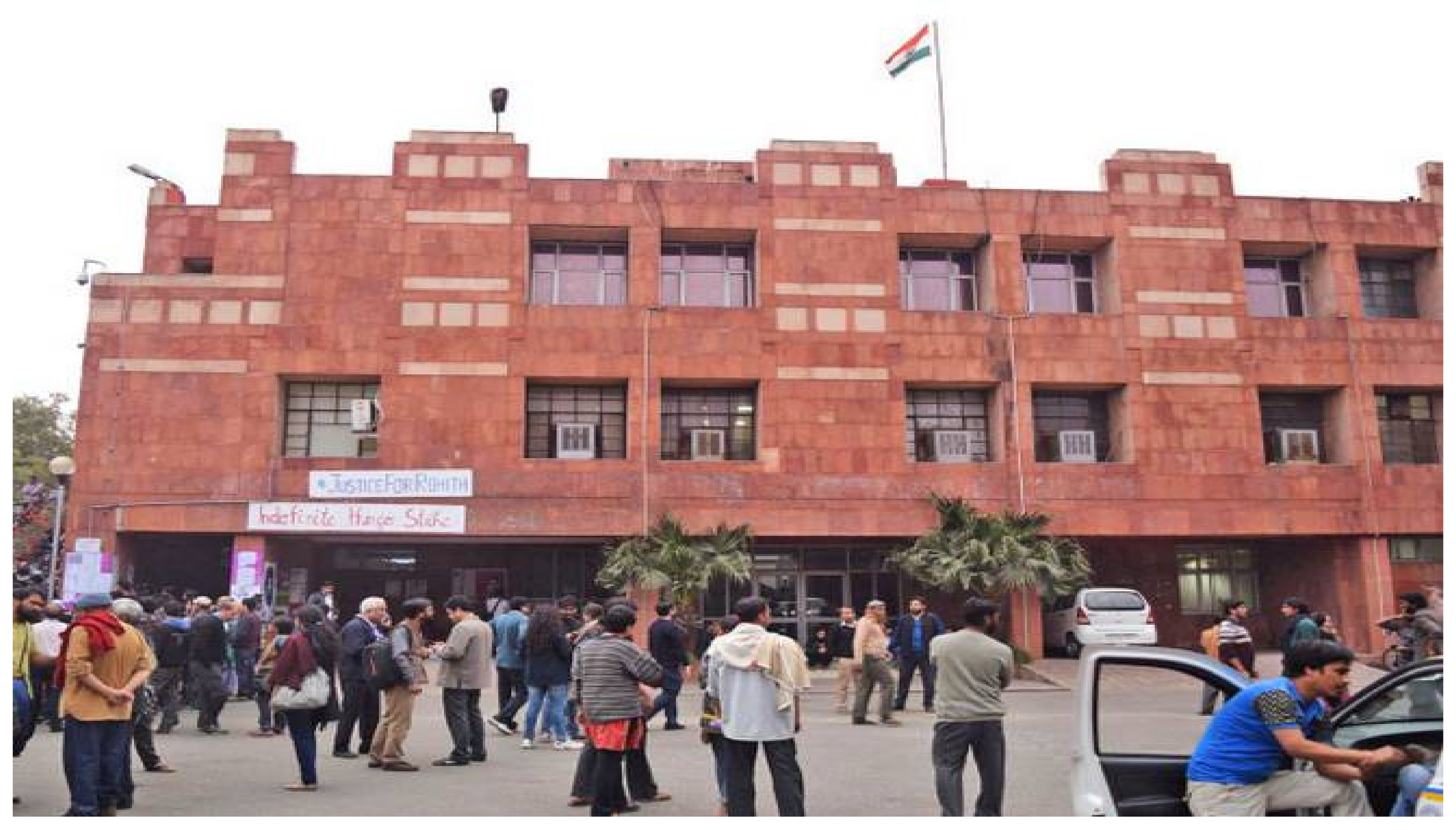
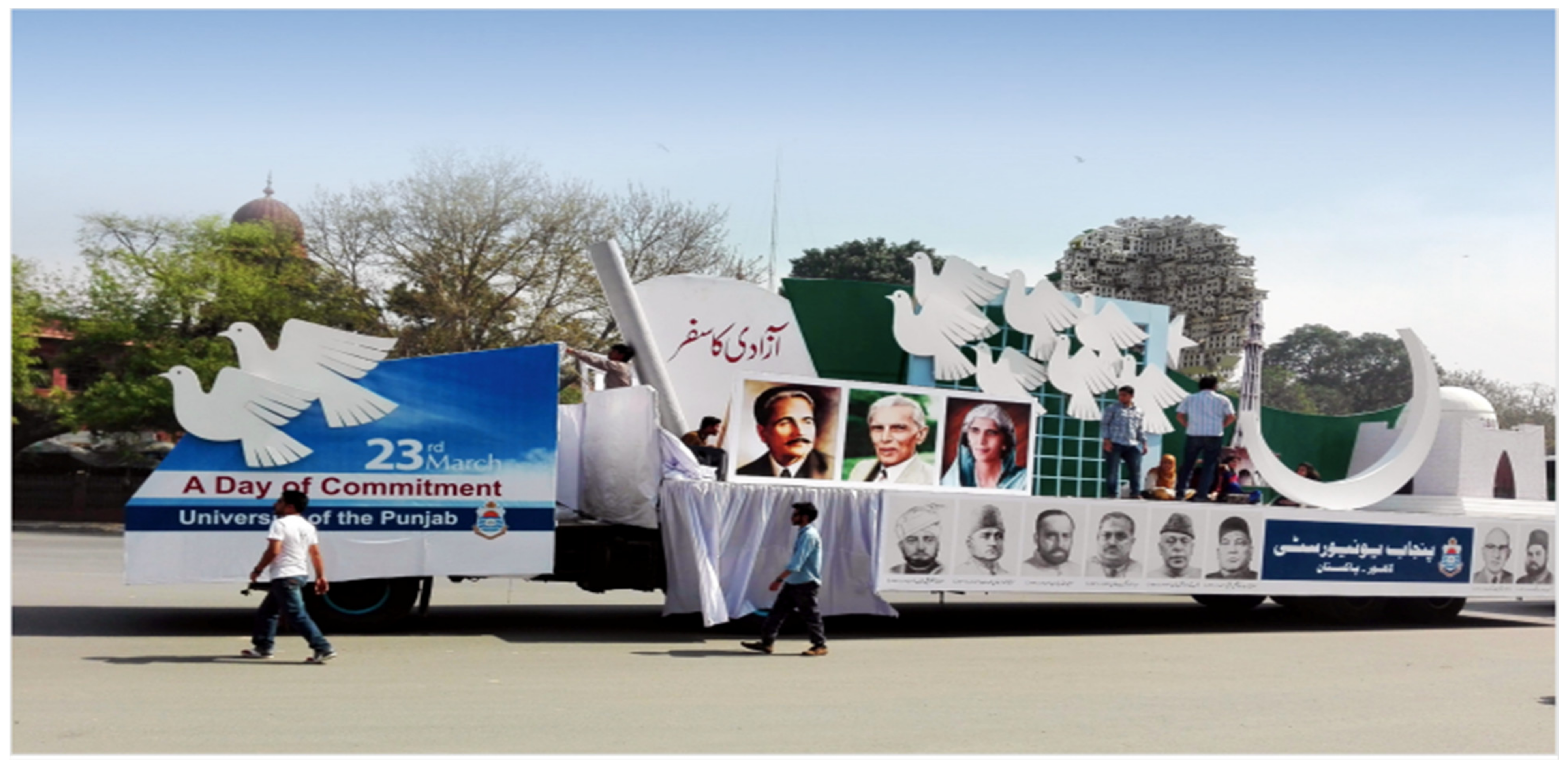

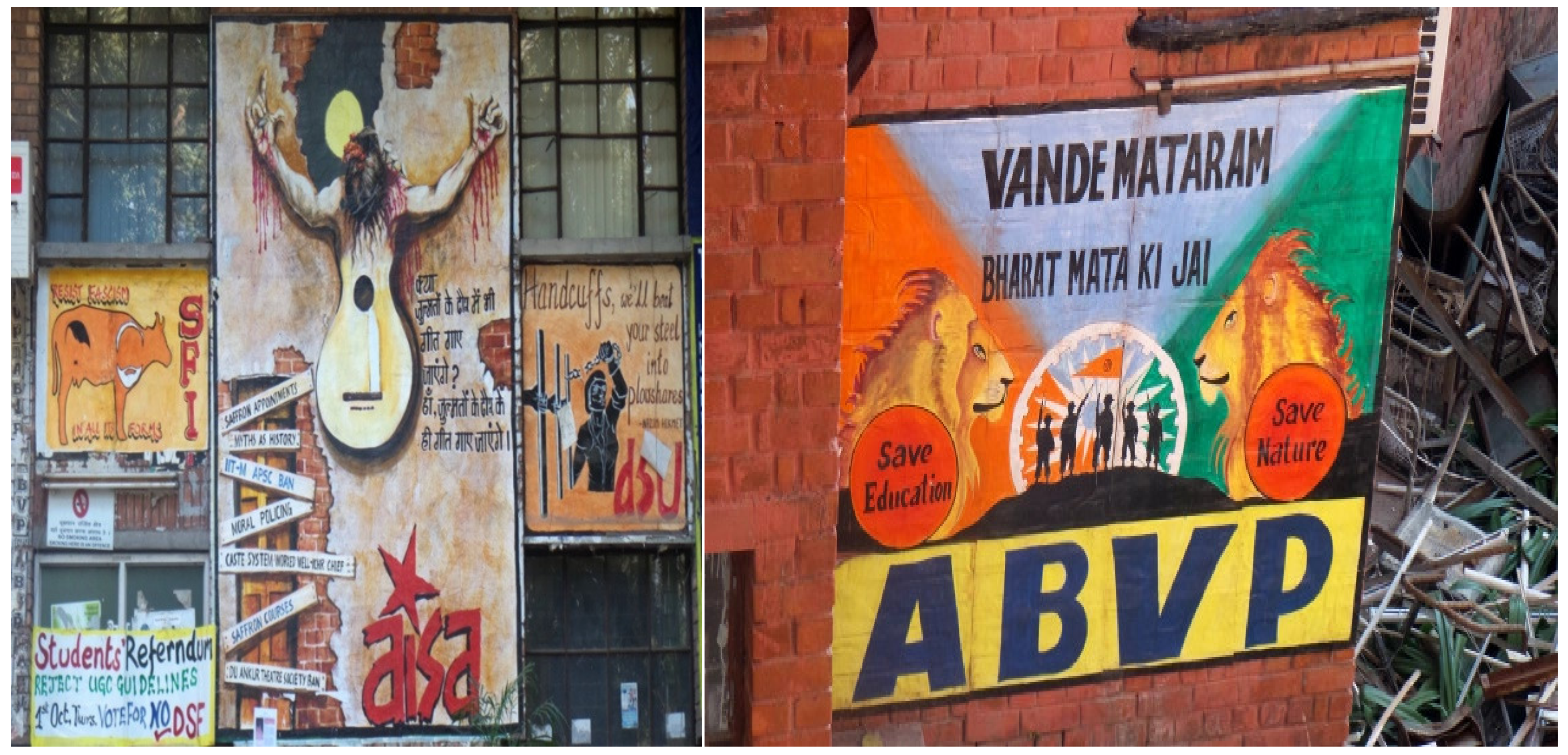
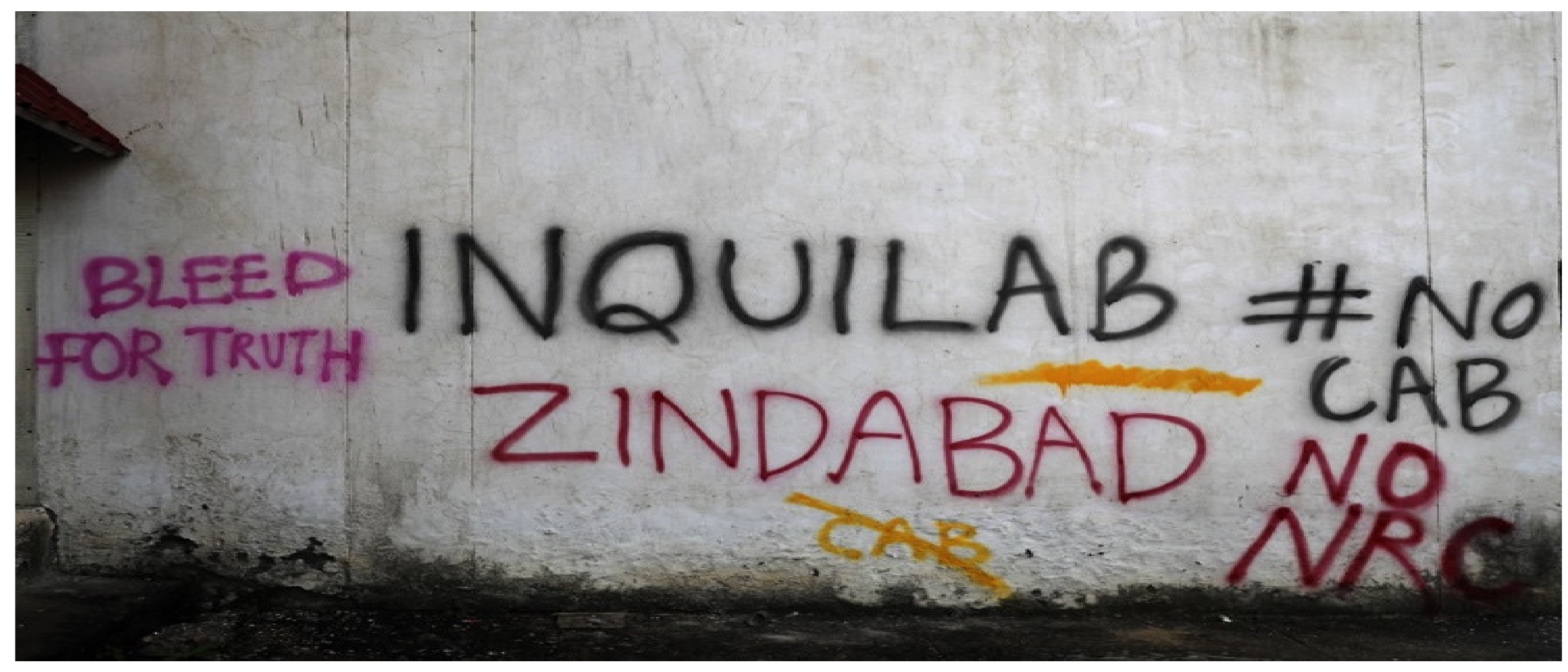
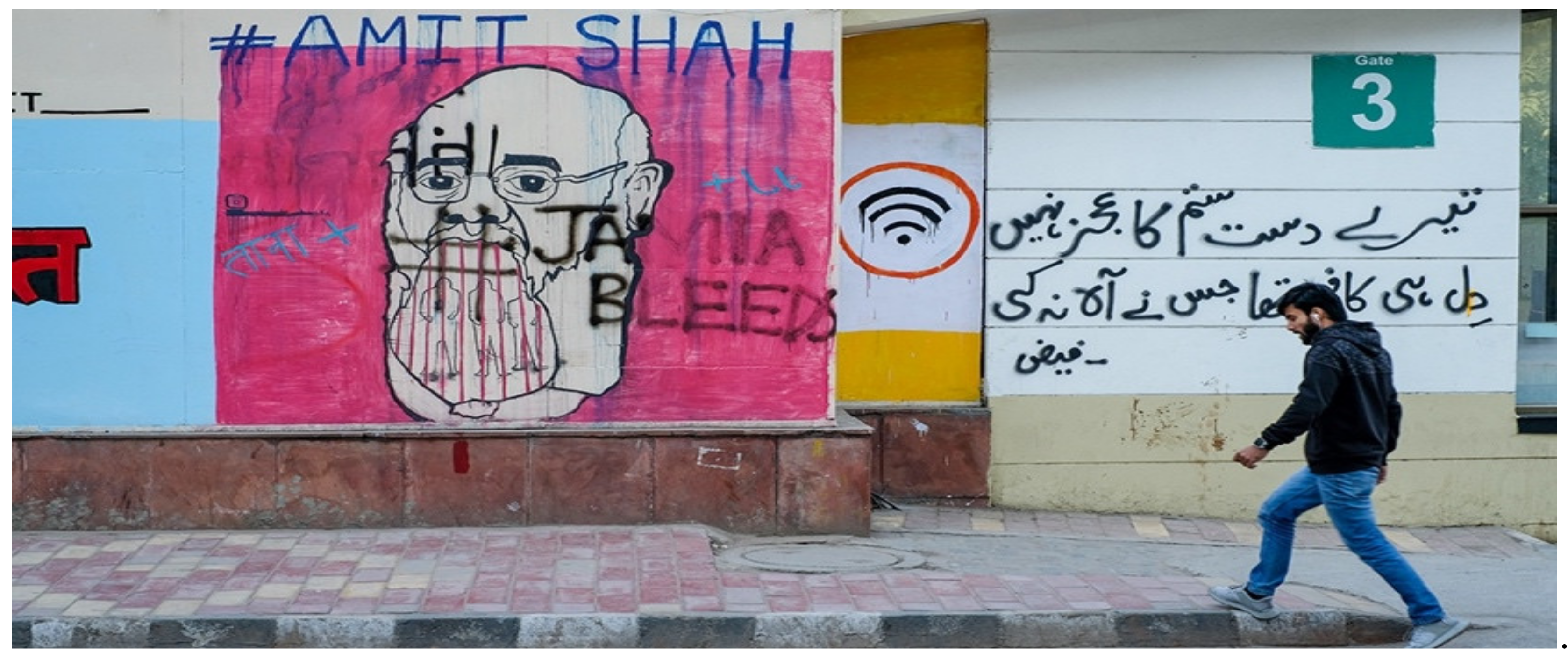
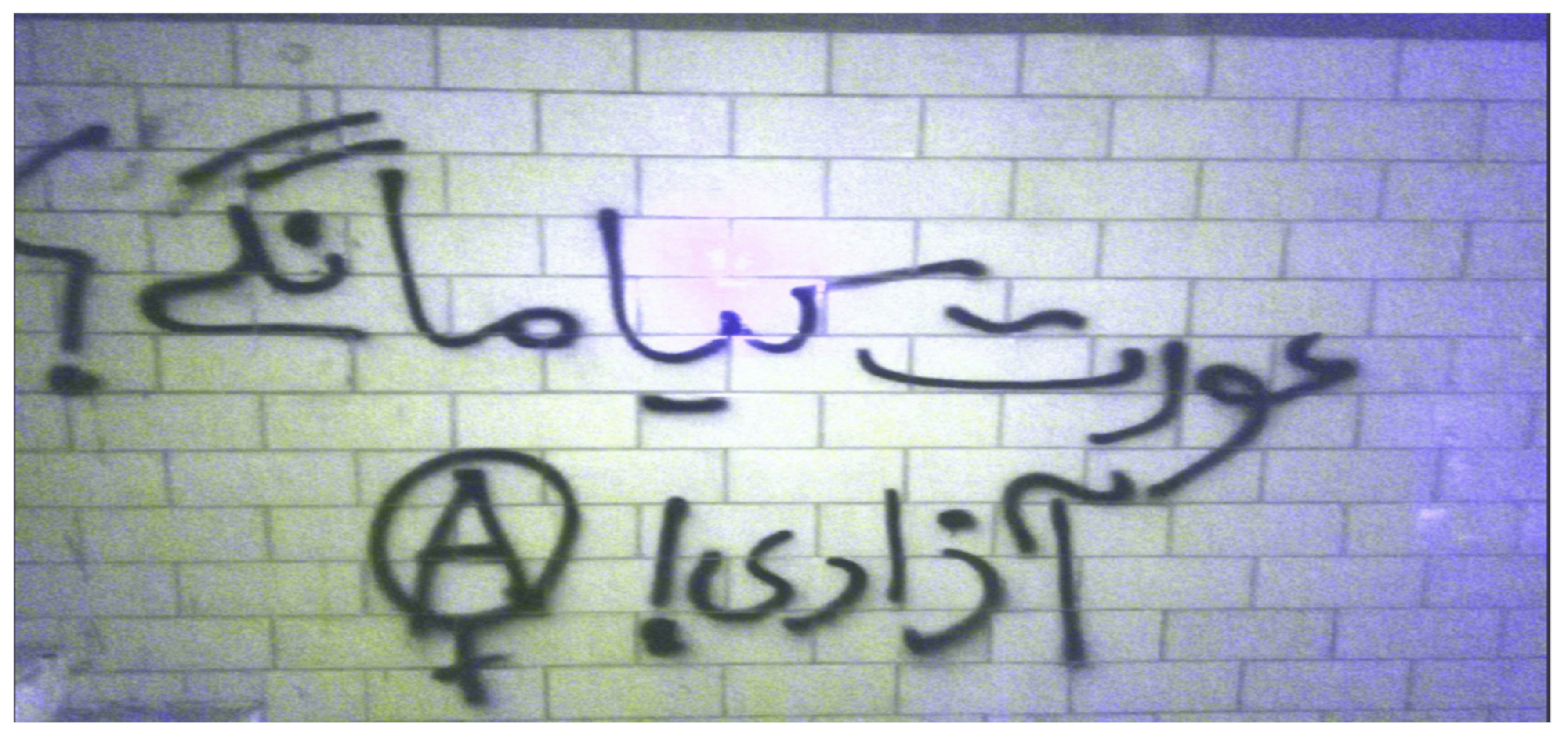

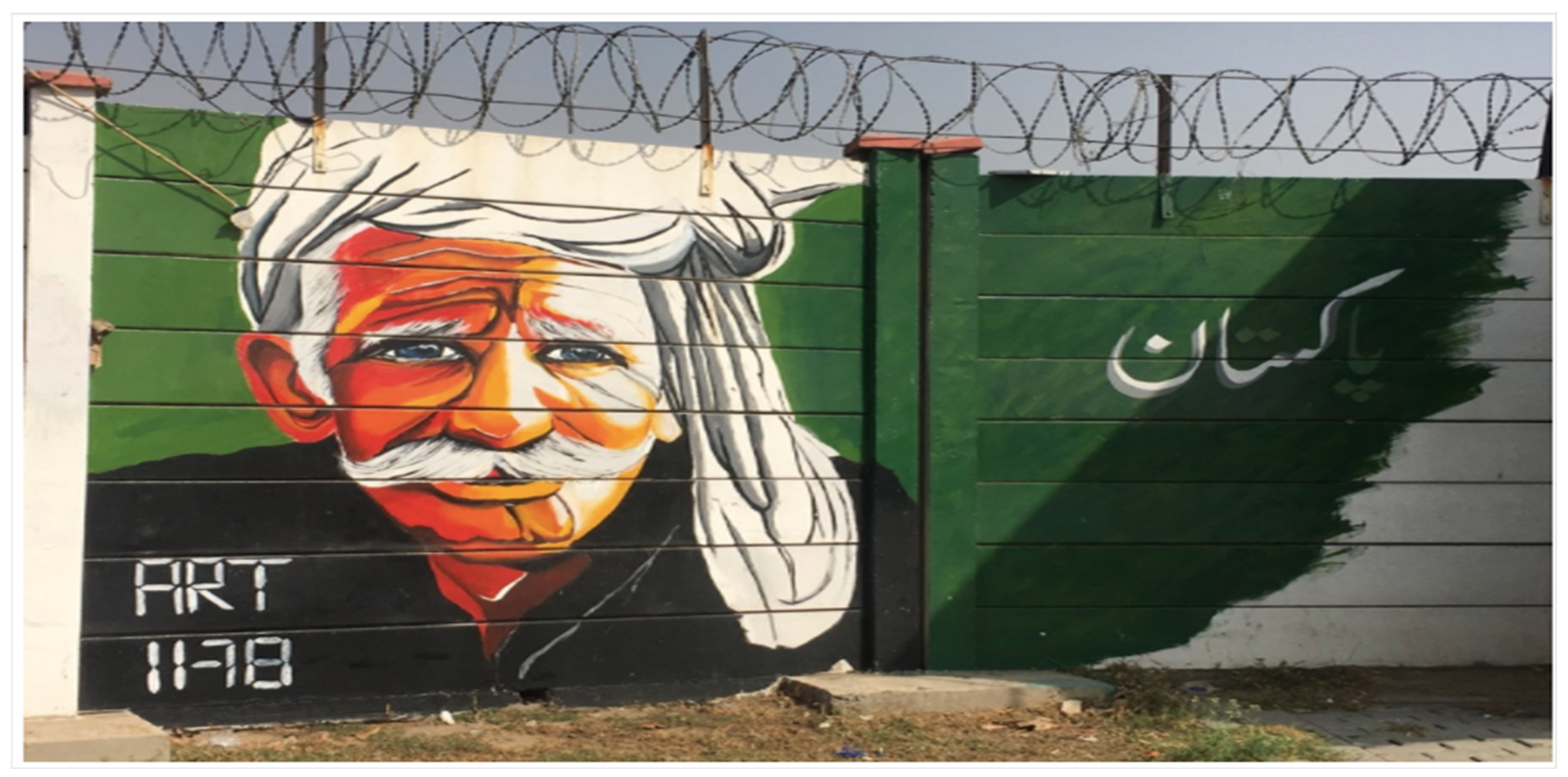
| Images Collected in Numbers | ||||
|---|---|---|---|---|
| Source of Data | JNU | JMIU | PU | GCU |
| Step 1: Official University Websites | 12 | 14 | 10 | 16 |
| Step 2: University Policy Documents | 17 | 10 | 15 | 8 |
| Step 3: News Articles and Blog Posts | 20 | 15 | 18 | 12 |
| Step 4: Social Media Presence | 10 | 12 | 11 | 14 |
Publisher’s Note: MDPI stays neutral with regard to jurisdictional claims in published maps and institutional affiliations. |
© 2021 by the authors. Licensee MDPI, Basel, Switzerland. This article is an open access article distributed under the terms and conditions of the Creative Commons Attribution (CC BY) license (https://creativecommons.org/licenses/by/4.0/).
Share and Cite
Niaz, L.; Anand, K. University Spaces as Agents of National Belonging: Analysing the Visual Culture of Public Universities’ Campuses in India and Pakistan. Educ. Sci. 2021, 11, 741. https://doi.org/10.3390/educsci11110741
Niaz L, Anand K. University Spaces as Agents of National Belonging: Analysing the Visual Culture of Public Universities’ Campuses in India and Pakistan. Education Sciences. 2021; 11(11):741. https://doi.org/10.3390/educsci11110741
Chicago/Turabian StyleNiaz, Laraib, and Kusha Anand. 2021. "University Spaces as Agents of National Belonging: Analysing the Visual Culture of Public Universities’ Campuses in India and Pakistan" Education Sciences 11, no. 11: 741. https://doi.org/10.3390/educsci11110741
APA StyleNiaz, L., & Anand, K. (2021). University Spaces as Agents of National Belonging: Analysing the Visual Culture of Public Universities’ Campuses in India and Pakistan. Education Sciences, 11(11), 741. https://doi.org/10.3390/educsci11110741







